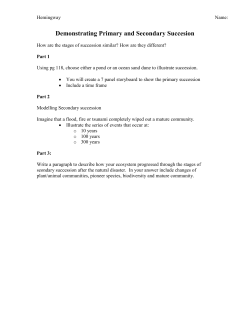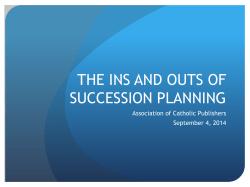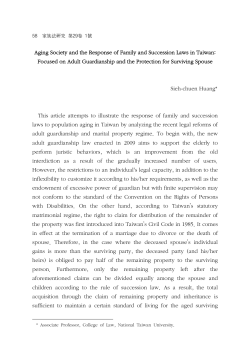
Organizational Learning Mechanisms and Leadership Succession
ORGANIZATIONAL LEARNING MECHANISMS AND LEADERSHIP SUCCESSION: KEY ELEMENTS OF PLANNED SCHOOL CHANGE Chen Schechter Ilana Tischler ABSTRACT The growing complexity of schoolwork in the current turbulent and unstable environment requires schools to plan for both structural and pedagogical changes. Planning for school change, however, has been increasingly hindered by leadership succession that dramatically affects organizational stability. Although a common phenomenon in our competitive educational realm, leadership succession during school change process has been under-explored. This article illuminates both processes of leadership succession and Organizational Learning Mechanisms (OLMs) as key elements in planned school change. It is argued that institutionalizing OLMs (arenas where knowledge can be analyzed and shared by individual members and then become the property of the entire organization through dissemination and changes in standard routines and procedures) can support the development and retention of a school’s memory; thus sustaining the change efforts subsequent to the departure of the original reformer(s). INTRODUCTION Seven years ago, the owner landscaped the place. He wanted a no-maintenance garden with beauty bark, perennials, and shrubs. Three years later he moved, just as the garden was beginning to develop. The next owners, avid gardeners, wanted a Victorian garden with flowers galore. They ripped out shrubs, got rid of the beauty bark, and planted more flowers. They stayed two years, and then I moved in. I wanted a no-maintenance, shrub-and-flower garden. Over the past two years, I’ve planted some of the same shrubs as the first owner had, brought in a little beauty bark, dispensed with some of the flowers the second owner put in, and planted a few more perennials. Had we been able to coordinate the garden design (which, of course, we could not) the whole thing would be lushly full by now. (Wasley, 1992, p. 65) Leadership succession is gaining attention as a significant factor affecting organizational performance and student achievement. Leadership succession becomes even more critical as educational systems place a higher value on change processes that influence the entire school community (Brock & Grady, 1995). Nevertheless, this transition period in the leadership role heightens organizational members’ sense of uncertainty, which limits the ability to implement change (Cuban, 2001). An important way to help administrators and teachers overcome their sense of uncertainty can be careful planning. Guskin (1996) stresses the importance of planning a transition, rather that just letting it happen, suggesting that we should “plan a brief leadership transition period beginning with the previous [principal]’s announcement of intention to leave, allowing the institution to acknowledge its loss, and setting the stage for healthy, productive new relationships (p. 12). This is especially important during times of change. In order to maintain the change, learning patterns should be ingrained in the organizational culture, pedagogical practices, and leadership. Yet, such qualitative patterns are complicated and often compromised by the occurrence of leadership transition during the change process. Many studies in education deal with change processes and leadership. The actual leadership succession during a change process, however, is under-explored. Thus, there is still a gap in the specific area of the impact of leadership succession on an ongoing school change process. More specifically, the literature that does exist is more commonly centered on executive transitions in public organizations. In the field of education, there has been some limited research on superintendent transitions and teachers’ perceptions of succession. This literature, however, tends to focus on the process of searching for new leadership, the organizational effects of leadership succession, and the different reasons for a transition in the leadership role (e.g., retirement, board dissatisfaction), rather than on the transition phase itself. It appears, then, that a neglected but important subject of inquiry is the question of how a successful change can be sustained subsequent to the departure of the original reformer. 1 Vol. 16, No. 2 Our basic assumption is that the majority of change processes do not take the transition period fully into consideration, not only from the logistic perspective, but also from the knowledge management perspective that supports the retention of an organization’s professional excellence while building an institutional memory. Thus, the lack of attention paid to the period of leadership transition represents a critical omission of an important process during times of school change. This article introduces both concepts of leadership succession and organizational learning mechanisms (OLMs) as key elements in the context of school change. Both concepts are explained, followed by some suggestions for theorizing the interrelationships between leadership succession and OLMs. Finally, further inquiry regarding these interrelated processes is suggested. LEADERSHIP SUCCESSION Leadership succession is the actual transition period, during which one school principal takes over the position of another. Fox and Lippitt found that one of the main “[d]ifficulties that mitigates against the most effective involvement of the state organization included rapid turnover in leadership” (1967, p. 2). Similarly, Hargreaves and Fink (2000), 33 years later, reviewed two schools’ failure to sustain their innovative character, and found that “both schools experienced problems with leadership succession” (p. 30). These problems in leadership succession are due to the creation of other forces of change (Kirkland, 1991), as well put by Miskel and Cosgrove: Succession is a disruptive event that changes the line of communication and relationships of power, effects decision making, and generally disturbs the equilibrium on normal activities. During the succession period, relationships are formed and negotiated, expectations between parties are confirmed or disconfirmed, conflicts may be confronted and resolved, and new leaders are accommodated or not in their work role and the new environment. (cited in Hart, 1991, p. 452) It appears, then, that leadership succession is a complex process encompassing both individual and organizational features. Thus, whether a leader’s departure is long anticipated, or announced as he or she walks out the door, it is a dynamic, often a disruptive, event for those who remain (Briggs, 2000). Leadership succession can dramatically affect organizational stability. In fact, changes in leadership are commonly used to initiate educational changes. Concurrently, Wasley (1992) suggested that leadership succession can impede a change process already underway, arguing that “good efforts at change are dismantled and a new plan constructed, only to be taken apart when the next leadership transition occurs” (p. 64). Thus, there is a link between the concepts of leadership succession and educational change. So, what are the organizational strategies used to cope with transition and change? Sheppard and Brown (1999) argued that a precondition for successful change is that principals initiate structures that encourage distributed collaborative leadership. These structures, routines, and behavioral regularities, based on information processing, become a source of stability and change during leadership succession. SCHOOL LEARNING MECHANISMS School capacity for innovation and reform relies on its ability to collectively process, understand, and apply knowledge about teaching and learning (Louis, 1994). This argument is supported by Spender and Grant’s (1996) criticism of schools’ over-emphasis on what should be learned, instead of the process of knowledge acquisition, creation, dissemination and integration. Focusing on gathering and processing information within and between schools, according to Barnes (2000), requires establishing opportunities for teachers to collectively think and share information on a sustained basis. Therefore, schools need to establish “system structures, processes and practices that facilitate continuous [collective] learning of all its members” (Silins & Mulford, 2002, p. 444). With this said, Huber (1991), Marquardt (1996) and DiBella, Nevis, and Gould (1996) classified five phases of the information processing (learning) cycle: (a) information acquisition: the process of obtaining knowledge. This includes experiential learning (organizational experiments, organizational self-appraisal, such as action research), vicarious learning in which organizations attempt to learn from strategies and technologies of other organizations, grafting-recruiting new members who possess knowledge that is not available to the organization, and searching and noticing the environment; (b) Educational Planning 2 information distribution: the process of sharing information that leads to understanding; (c) information interpretation: the process in which the distributed information is given meaning. The more learning, the more interpretations are developed; (d) organizational memory: the processes and means by which organizational experiences are stored and coded into organizational memory; and, (e) retrieving information from memory for organizational use. Although these five phases of information processing are ordered progressively, learning is perceived as a cyclical and interactive process. To operationalize organizational systems from an information processing perspective, Popper and Lipshitz (1998, 2000) have proposed a structural approach to organizational learning. The structural approach posits that organizational learning entails the existence of Organizational Learning Mechanisms (OLMs) that are structural and procedural institutionalized arrangements for collecting, analyzing, storing, and disseminating information that is relevant to the performance of the organization and its members (see also DiBella, Nevis & Gould, 1996; Huber, 1991; Marquardt, 1996). OLMs are concrete arenas where knowledge can be analyzed and shared by individual members and then become the property of the entire organization through dissemination and changes in standard routines and procedures. The structures and processes of OLMs serve as an analogue to the individual nervous system and explain how the organization can learn in a non-metaphorical and nonparadoxical way (Lipshitz & Popper, 2000). Consequently, learning around OLMs relates learning by individual members to learning by organizations. Beyond the scope of this manuscript, there are various barriers to OLMs based on collective information processing. For example, an important barrier can emerge when organizational OLMs are controlled by higher levels in the hierarchy, using them as a leverage to sustain power and status-quo. Information processing through OLMs also can blind an effective scanning of the environment and produce blindness that may result in crisis (Nystrom & Starbuck, 1984). LEADERSHIP SUCCESSION AND OLMS Leadership succession and OLMs are important and interrelated processes, however, often unexplored, especially in light of renewal efforts. Therefore, exploring these processes may contribute to the field of planned educational change. With this said, below are some suggestions for theorizing the interrelated processes of leadership succession and OLMs. Integrative structures (e.g., weekly grade-level meetings) that enable a process of collaboration are essential for effective leadership succession (Galbraith, 1977; Lawrence & Lorsch, 1967; Lipshitz & Popper, 2000). Going through a transition period in leadership, it should be relatively easier to implement and sustain change programs when information is scanned, interpreted, and shared by the majority of members (Ellis & Maidan, 1997). Especially at times of administrative turnover, organizations with a high intensity of using structural learning mechanisms, when they are systematic, participative, flexible, and dynamic (Bell, 2002), show more shared knowledge (congruence among members’ mental models) that reflects the message of change. In this regard, peer observations, monthly departmental meetings according to subject areas, monthly whole faculty meetings, and monthly meetings of teachers with the subject’s superintendent, to mention only a few learning mechanisms, form the basic building blocks for the successful continuity of school change through the leadership transition. In other words, learning spaces, based on professional discourse, create a collective memory that has a more powerful impact on organizational members than the often turbulent period of leadership-administrative succession. As OLMs represent a distributed knowledge throughout the entire organization, rather than confined to a central location of one (e.g., principal) particular knowledge system (Walsh & Ungson, 1991), the information shared by teachers represents qualities of schools. Similarly, studying leadership succession at the school level reflects the continuous attempts to break out from analyzing a school’s members and functions as isolated to capturing the dynamic and interrelated school processes embedded within the complex phase of leadership succession. In this way, perceiving the interrelated processes of leadership succession and OLMs as school level attributes represents the need to approach school change from a more holistic and participative perspective. Principals are key players in introducing reflexive spaces-forums-mechanisms into the ongoing school structure. Whereas schools are still perceived to operate according to hierarchical and rational 3 Vol. 16, No. 2 bureaucratic models (Sheppard & Brown, 1999), OLMs in schools demands leadership that “is about learning together and constructing meaning and knowledge collectively and collaboratively” (Lambert, 1998, p. 5). Principals need to establish OLMs (time and space) that systematically continue after the principal initiator is no longer around. In other words, principals need to conduct ongoing learning processes within the staff that continue after the transition. In this way, innovative practices are less affected by the transition because teachers’ knowledge and shared memory with regard to organizational practices become the infrastructure of the reform. The transition should be communicated, explained, and prepared ahead of time. Each individual in the school must be treated as a unique person experiencing a significant change in his or her own professional life. The new leader should meet with the staff on a regular basis, and discuss the main issues each individual experiences before and after the transition process, on the personal as well as the professional level. Such discussions act as a valuable source of information for the staff and for the new leader alike. There should be a mandated overlap period for any transition in leadership position. The time of overlap may vary, anywhere from two weeks to two months, depending on the circumstances. Even when the leader is fired, he or she is still expected, and even obligated as part of the contract, to properly hand the leadership to the new leader. The baseline assumption is that the transition period has a major impact on the organization, and as such must be handled with care in order to create the most efficient process toward nurturing the school memory. In doing so, an overlap period prevents time and cost involved in starting over ‘from scratch.’ It is recommended that the predecessor and the successor be on site together during a transition, helping to clarify the process for both the leaders and the faculty. PHASES OF LEADERSHIP SUCCESSION DURING PERIODS OF SCHOOL CHANGE The following phases are suggested as a means of nurturing the school memory during times of change. These phases cannot be perceived as linear, but rather as symbiotic and closely interrelated. • Introduction of systematic and participative modes of collective learning based on information processing; • An initial change process, categorized by principal's modeling of how to approach and express the new knowledge. The information pertaining to the change is shared and analyzed in concrete arenas of OLMs and then becomes the property of the entire organization through dissemination and changes in standard routines and procedures. Thus, OLMs create a collective memory of the building blocks of the reform; • A transition period that includes preparation for the actual transfer of authority. The new leader has to learn about the history, values, traditions and assumptions of the 'old' school by inquiring into the standard routines and procedures before, during, and after the overlap period; and, • A post-transition period featuring continuity and alteration of school culture and pedagogical practices as communicated through OLMs. The phases, as described above, enable the school to sustain its successful reform, while staying open to new and alternative ideas as communicated by the new leadership through OLMs. CONCLUSION AND FURTHER EXPLORATION School change efforts are generally a response to a perceived failure and/or problem. It can be assumed that the pressure associated with responding to failed events directs cognitive attention toward seeking immediate causes, during which participants cannot let down their defenses and open themselves up to exploring and questioning themselves and others. These change efforts often inhibit schools from becoming learning organizations, increasing professional saturation, distraction, and cynicism among practitioners (Brooks, Placier, & Cockrell, 2003). Nevertheless, in light of the complex and uncertain environments in which schools operate, effective planned change and adaptation occur when learning takes place throughout the organization (West, 1994). Planned school change needs to be based on the networks of social processes among community members (Marks & Louis, 1999), which encourage a more systematic and less biased inquiry into learners’ mental models. Rosenholtz (1989), in this regard, found that developing schools, wherein teachers learned from Educational Planning 4 each other through a collective enterprise, was more effective than ‘stuck’ schools that had difficulties implementing changes. This was supported by Wohlstetter, Smyer and Mohrman’s (1994) findings that “the most significant common element across actively restructuring schools was the extent to which organizational mechanisms were in place that generated interactions for school-level actors around issues related to curriculum and instruction” (p. 278). The growing evidence suggests that an extensive use of collective learning mechanisms (OLMs) related to curriculum and instruction promotes greater teacher commitment and student engagement in school practices (Bryk & Driscoll, 1988; Bryk, Camburn, & Louis, 1999; Bryk, Lee, & Holland, 1993; Rowan, 1993). Moreover, teachers’ collegial learning enhances faculty tendency toward experimentation and innovation in the context of planned change. Thus, collegial learning increases teachers’ inquiry into instructional materials and practices within school, which in turn, facilitates the use of innovative pedagogical methods that are consistent with school change efforts (Bidwell & Yasumoto, 1999; Camburn, 1997; Marks & Louis, 1997). As collective learning processes are in contrast to teachers’ pedagogical isolation-autonomy, which so often prevails in schools, particularly in secondary ones (Printy, 2002), the principal’s role should focus on providing the context (time and space) for dialogue. Principals are responsible for establishing and consistently using processes in which teachers, students, administrators, as well as parents work, together on professional problems as the seeds of any planned change. In this regard, these structures, routines, and behavioral regularities, based on information processing, become a source of stability and change during leadership succession. As OLMs represent a distributed knowledge throughout the entire organization, rather than confined to a central location of one (e.g., principal) particular knowledge system (Walsh & Ungson, 1991), planned change efforts can be more effectively sustained despite leadership succession. Another aspect of such can be found in the role of the new principal to not only initiate collective learning mechanisms as a means for negotiating and planning future school change, but also to consider the collective memory and learning routines established by the former principal(s). The process of leadership succession during times of school change is one that has been neglected and under-explored, calling for further conceptualization and empirical research. More specifically, how is it that components of change are implemented in such a way that they become basic assumptions of the organization, remaining stable even in the midst of a leadership transition? What is the relationship between leadership succession, extensive use of OLMs, members’ mental models, and pedagogical practices? What is the contribution of these collective spaces of information processing to the overall change process during administrative turnover? Furthermore, from a political perspective, how does the extensiveness of OLMs affect the new administration’s legitimacy to either sustain or alter the change? During times of leadership succession, can the school benefit more from informal channels of information processing than from formal ones? And finally, there is a need to conceptualize and operationalize the principal’s role in creating organizational learning structures in the context of leadership succession. REFERENCES Barnes, N. (2000). Teachers training teachers. Education Week, 19, 38-42. Bell, L. (2002). Strategic planning and school management: Full of sound and fury, signifying nothing? Journal of Educational Administration, 40(5), 407-424. Bidwell, C. E., & Yasumoto, J. Y. (1999). The collegial focus: Teaching fields, collegial relationships, and instructional practice in American high schools. Sociology of Education, 72(4), 234-256. Briggs, D. (2000). Managing leadership transitions in education partnerships. San Francisco, CA: WestEd. Brock, B., & Grady, M. (1995). Principals in transition: Tips for surviving succession. Thousand Oaks, CA: Corwin Press. Brooks, J. S., Placier, M., & Cockrell, K. S. (2003, November). Exploring the dark side of school reform: Teacher professional community and anomie. Paper presented at the annual convention of the University Council for Educational Administration, Portland, OR. Bryk, A. S., & Driscoll, M. E. (1988). The school as community: Theoretical foundations, contextual influences, and consequences for students and teachers. Chicago: Center for School Improvement at the University of Chicago. 5 Vol. 16, No. 2 Bryk, A., Camburn, E., & Louis, K. S. (1999). Professional community in Chicago elementary schools: Facilitating factors and organizational consequences. Educational Administration Quarterly, 35(5), 751-781. Bryk, A. S., Lee, V. E., & Holland, P. B. (1993). Catholic schools and the common good. Cambridge, MA: Harvard University Press. Camburn, E. (1997). The impact of professional community on teacher learning and instructional practice. Unpublished Dissertation, University of Chicago, Chicago, IL. Cuban, L. (2001). Oversold and underused: Computers in the classroom. Cambridge, MA: Harvard University Press. DiBella, A. J., Nevis, E. C., & Gould, J. M. (1996). Understanding organizations learning capability. Journal of Management Studies, 33(3), 361-379. Easterby-Smith, M. (1997). Disciplines of the learning organizations: Contributions and critiques. Human Relations, 50, 1085-1113. Ellis, S., & Maidan-Gilad, N. (1997). Effects of organizational learning mechanisms on organizational performance and shared mental models during planned change. The Recanati Graduate School of Business Administration: Tel-Aviv University. Fox, R., & Lippitt, R. (1967). The innovation and sharing of teaching practices - II: Procedures for stimulating adoption and adaptation of selected teaching practices (Final Report). (ERICReproductionServiceNo.ED030297). Galbraith, J. (1977). Organization design. Reading, MA: Addison-Wesley. Guskin, A. E. (1996). Soft landing for new leaders. Trusteeship, 4(1), 12-16. Hargreaves, A., & Fink, D. (2000). The three dimensions of reform. Educational Leadership, 57(7), 30-33. Hart, A. (1991). Leader succession and socialization: A synthesis. Review of Educational Research, 61(4), 451-474. Huber, G. P. (1991). Organizational learning: The contributing processes and the literatures. Organizational Science, 2, 88-115. Kirkland, T. P. (1991, April). A grounded theory of community college presidential succession. Paper presented at the Annual Meeting of the American Education Research Association, Chicago, IL. Lambert, L. (1998). Building leadership capacity in schools. Alexandria, VA: Association for Supervision and Curriculum Development. Lawernce, P., & Lorsch, J. (1967). Organization and environment. Boston, MA: Harvard University Graduate School of Business Administration. Lipshitz, R., & Popper, M. (2000). Organizational learning in a hospital. Journal of Applied Behavioral Science, 36(3), 345-361. Louis, K. S. (1994). Beyond managed change: Rethinking how schools improve. School Effectiveness and School Improvement, 5(1), 2-24. Marks, H. M., & Louis, S. K. (1999). Teacher empowerment and the capacity for organizational learning. Educational Administration Quarterly, 35(5), 707-750. Marquardt, M. J. (1996). Building the learning organization. New-York: McGraw-Hill. Nystrom, P.C., & Starbuck, W.H. (1984). To avoid organizational crisis, unlearn. Organizational Dynamics, 13, 53-65. Popper, M., & Lipshitz, R. (1998). Organizational learning mechanisms: A cultural and structural approach to organizational learning. Journal of Applied Behavioral Science, 34, 161- 178. Popper, M., & Lipshitz, R. (2000). Organizational learning: Mechanisms, culture and feasibility. Journal of Management Learning, 31, 181-196. Printy, S. (2002, November). Communities of practice: Their professional impact. Paper presented at the Annual Meeting of The University Council for Educational Administration, Pittsburgh, PA. Rosenholtz, S. J. (1989). Teachers’ workplace: The social organization of schools. Teachers College Press. New York, NY. Rowan, B. (1993). Teaching as a nonroutine task: Implications for the management of schools. Educational Administration Quarterly, 29(4), 479-500. Educational Planning 6 Sheppard, B., & Brown, J. (1999, April). Leadership approach, the new work of teachers and successful change. Paper presented at the Annual Meeting of the American Educational Research Association, Montreal, Canada. Silins, H. C., & Mulford, W. R. (2002). Schools as learning organizations. Journal of Educational Administration, 40(5), 425-446. Spender, J., & Grant, R. M. (1996). Knowledge and the firm: Overview. Strategic Management Journal, 17, 5-10. Walsh, J. P., & Ungson, G, R. (1991). Organizational memory. Academy of Management Review, 16(1), 57-91. Wasley, A. P. (1992). When leaders leave. Educational Leadership, 50(3), 64-67. West, P. (1994). The concept of the learning organization. Journal of European Industrial Training, 18(1), 15-21. Wohlstetter P., Smyer, R., & Mohrman, S. A. (1994). New boundaries for school-based management: The high involvement model. Educational Evaluation and Policy Analysis, 16, 268-286 7 Vol. 16, No. 2
© Copyright 2025









